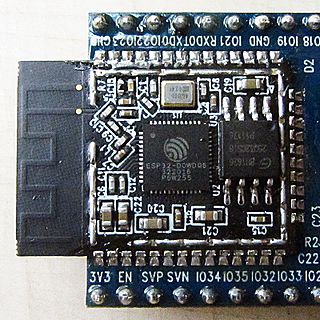Related Research Articles
Atmel Corporation was a creator and manufacturer of semiconductors before being subsumed by Microchip Technology in 2016. Atmel was founded in 1984. The company focused on embedded systems built around microcontrollers. Its products included microcontrollers radio-frequency (RF) devices including Wi-Fi, EEPROM, and flash memory devices, symmetric and asymmetric security chips, touch sensors and controllers, and application-specific products. Atmel supplies its devices as standard products, application-specific integrated circuits (ASICs), or application-specific standard product (ASSPs) depending on the requirements of its customers.

A doorbell is a signaling device typically placed near a door to a building's entrance. When a visitor presses a button, the bell rings inside the building, alerting the occupant to the presence of the visitor. Although the first doorbells were mechanical, activated by pulling a cord connected to a bell, modern doorbells are electric, operated by a pushbutton switch. Modern doorbells often incorporate intercoms and miniature video cameras to increase security.
Nordic Semiconductor ASA was founded in 1983 and is a Norwegian fabless technology company with its headquarters in Trondheim, Norway. The company specializes in designing ultra-low-power wireless communication semiconductors and supporting software for engineers developing and manufacturing Internet of Things (IoT) products.
Digi International, Inc. is an American Industrial Internet of Things (IIoT) technology company based in Hopkins, Minnesota.

Z-Wave is a wireless communications protocol used primarily for residential and commercial building automation. It is a mesh network using low-energy radio waves to communicate from device to device, allowing for wireless control of smart home devices, such as smart lights, security systems, thermostats, sensors, smart door locks, and garage door openers. The Z-Wave brand and technology are owned by Silicon Labs. Over 300 companies involved in this technology are gathered within the Z-Wave Alliance.

A home network or home area network (HAN) is a type of computer network that facilitates communication among devices within the close vicinity of a home. Devices capable of participating in this network, for example, smart devices such as network printers and handheld mobile computers, often gain enhanced emergent capabilities through their ability to interact. These additional capabilities can be used to increase the quality of life inside the home in a variety of ways, such as automation of repetitive tasks, increased personal productivity, enhanced home security, and easier access to entertainment.

Telit Cinterion is an Internet of Things (IoT) Enabler company headquartered in Irvine, California, United States. It is a privately held company with key operations in the US, Brazil, Italy, Israel, and Korea.
Qualcomm Atheros is a developer of semiconductor chips for network communications, particularly wireless chipsets. The company was founded under the name T-Span Systems in 1998 by experts in signal processing and VLSI design from Stanford University, the University of California, Berkeley, and private industry. The company was renamed Atheros Communications in 2000 and it completed an initial public offering in February 2004, trading on the NASDAQ under the symbol ATHR.
Microchip Technology Incorporated is a publicly listed American corporation that manufactures microcontroller, mixed-signal, analog, and Flash-IP integrated circuits. Its products include microcontrollers, Serial EEPROM devices, Serial SRAM devices, embedded security devices, radio frequency (RF) devices, thermal, power, and battery management analog devices, as well as linear, interface and wireless products.
NXP Semiconductors N.V. (NXP) is a Dutch semiconductor manufacturing and design company with headquarters in Eindhoven, Netherlands. It is the third largest European semiconductor company by market capitalization as of 2024. The company employs approximately 34,000 people in more than 30 countries and it reported revenues of $13.3 billion in 2023.

Wi-Fi Direct is a Wi-Fi standard for wireless connections that allows two devices to establish a direct Wi-Fi connection without an intermediary wireless access point, router, or Internet connection. Wi-Fi Direct is single-hop communication, rather than multi-hop communication like wireless ad hoc networks. The Wi-Fi Direct standard was specified in 2009.
Silicon Laboratories, Inc., commonly referred to as Silicon Labs, is a fabless global technology company that designs and manufactures semiconductors, other silicon devices and software, which it sells to electronics design engineers and manufacturers in Internet of Things (IoT) infrastructure worldwide.
Bluegiga Technologies Ltd. known as Bluegiga, is a Finnish wireless technology company based in Espoo, Finland. Founded in 2000, it has since expanded its offices to Atlanta in USA and Hong Kong. Bluegiga has been a member of the Bluetooth Special Interest Group since it was established and joined Continua Health Alliance in Spring 2008. The company joined Wi-Fi Alliance in the beginning of 2012.

Redpine Signals was a fabless semiconductor company founded in 2001. The company made chipsets and system-level products for wireless networks. It served the Internet of Things and wireless embedded systems market, enabling all volume levels of chipsets and modules.
Thread is an IPv6-based, low-power mesh networking technology for Internet of things (IoT) products. The Thread protocol specification is available at no cost; however, this requires agreement and continued adherence to an end-user license agreement (EULA), which states "Membership in Thread Group is necessary to implement, practice, and ship Thread technology and Thread Group specifications."
Smartphone ad hoc networks are wireless ad hoc networks that use smartphones. Once embedded with ad hoc networking technology, a group of smartphones in close proximity can together create an ad hoc network. Smart phone ad hoc networks use the existing hardware in commercially available smartphones to create peer-to-peer networks without relying on cellular carrier networks, wireless access points, or traditional network infrastructure. Wi-Fi SPANs use the mechanism behind Wi-Fi ad-hoc mode, which allows phones to talk directly among each other, through a transparent neighbor and route discovery mechanism. SPANs differ from traditional hub and spoke networks, such as Wi-Fi Direct, in that they support multi-hop routing and relays and there is no notion of a group leader, so peers can join and leave at will without destroying the network.
Sequans Communications is a fabless semiconductor company that designs, develops, and markets integrated circuits ("chips") and modules for 4G and 5G cellular IoT devices. The company is based in Paris, France with offices in the United States, United Kingdom, Israel, Hong Kong, Singapore, Taiwan, South Korea, Finland and China. The company was founded as a société anonyme in October 2003 by Georges Karam. It originally focused on the WiMAX market and expanded to the LTE market in 2009, dropping WiMAX altogether in 2011. Today the company develops and delivers only LTE chips and modules for the global 5G/4G cellular IoT market. Sequans was listed on the New York Stock Exchange in April 2011. Karam is the company's CEO.
MagnaCom is a technology IP license provider based in Israel and Orange County, California. The company is focused on reducing the bandwidth needed in wired and wireless communications, via the WAM technology, an alternative to Quadrature amplitude modulation The business provides technology to carriers, handset providers, wired and wireless companies, and is embedded in semiconductor chips.

ESP32 is a series of low-cost, low-power system on a chip microcontrollers with integrated Wi-Fi and dual-mode Bluetooth. The ESP32 series employs either a Tensilica Xtensa LX6 microprocessor in both dual-core and single-core variations, an Xtensa LX7 dual-core microprocessor, or a single-core RISC-V microprocessor and includes built-in antenna switches, RF balun, power amplifier, low-noise receive amplifier, filters, and power-management modules. ESP32 is created and developed by Espressif Systems, a Chinese company based in Shanghai, and is manufactured by TSMC using their 40 nm process. It is a successor to the ESP8266 microcontroller.

Blink is an American home automation company which produces battery-powered home security cameras. The company was founded in 2009 by Peter Besen, Don Shulsinger, Dan Grunberg, Stephen Gordon, and Doug Chin. The company was initially started as Immedia Semiconductor Inc in 2009, but pivoted into a consumer electronics company. In July 2014, the company had a Kickstarter campaign for their indoor security camera, which raised over US$1 million. Subsequently, Blink later announced an outdoor security camera, home security system, and video doorbell.
References
- ↑ "Embedded Wifi: 8 Questions with Bernard Aboussouan from Gainspan". Postscapes. Archived from the original on 13 May 2013. Retrieved 25 June 2013.
- 1 2 "Telit adds Wi-Fi and low-power solutions for IoT with acquisition of GainSpan to extend end-to-end IoT solutions reach". Telit. Retrieved 2024-01-16.
- ↑ Clive Maxfield (September 3, 2012). "GainSpan's reference design codes provide easy Wi-Fi connectivity". EE Times. Retrieved 25 June 2013.
- ↑ "GS1011MIxS and GS1011MExS". Industrial Embedded. Retrieved 25 June 2013.
- 1 2 Dan Primack (December 6, 2011). "Venture capital deals". CNN Money. Retrieved 25 June 2013.
- 1 2 Robbie Pleasant (July 4, 2012). "GainSpan Provides Wi-Fi in Overlooked Areas". Mobility Techzone. Retrieved 25 June 2013.
- ↑ Paula Bernier (July 18, 2011). "GainSpan Targets Niche Apps and More with Low Power Wi-Fi Solutions". TMC Net. Retrieved 25 June 2013.
- ↑ "GainSpan gets $18M in Series C funding". Business Journal. December 6, 2011. Retrieved 25 June 2013.
- ↑ Clive Maxfield (March 6, 2012). "GainSpan offers low-power Wi-Fi connectivity for Renesas MCU-based embedded systems". EE Times. Retrieved 25 June 2013.
- ↑ Nathesh (June 8, 2012). "Wireless Backhaul Industry News". TMC Net. Retrieved 25 June 2013.
- ↑ Clive Maxfield (June 24, 2012). "GainSpan Wi-Fi reference design code for TI MSP430". EE Times. Retrieved 25 June 2013.
- ↑ "Smart Grid Tuesday: GainSpan Gets New CEO, Hara Lines Up Safeway as Customer". www.greentechmedia.com. Retrieved 2023-09-25.
- ↑ "Move Over, Smart Meter: GainSpan Says WiFi is Here". www.greentechmedia.com. Retrieved 2023-09-25.
- ↑ Staff, Embedded (2013-02-26). "GainSpan combines Wi-Fi and ZigBee IP on a single chip". Embedded.com. Retrieved 2023-09-28.
- ↑ "Solem Electronique Selects GainSpan Low-Power Wi-Fi for Wireless Garden Automation Systems". www.prnewswire.com. Retrieved 2023-09-25.
- ↑ "Ring, Creator of the World's First Battery-Operated, Wireless, HD Video Doorbell, Selects GainSpan for Wi-Fi Module". GlobeNewswire News Room. 2015-01-05. Retrieved 2023-10-05.
- ↑ "Ring's smart doorbell can leave your house vulnerable to hacks". CNET. Retrieved 2023-10-05.
- ↑ "Telit Communications Acquires GainSpan | Mergr M&A Deal Summary". mergr.com. Retrieved 2023-12-19.
- ↑ "Telit Communications PLC agreed to acquire GainSpan Corporation from Opus Capital, In-Q-Tel, Inc. and others for $8 million. -February 31, 2017 | MarketScreener". www.marketscreener.com. 2017-02-01. Retrieved 2023-12-19.
- ↑ "Telit leverages GainSpan's technology team to strengthen its R&D in India - ET CIO". ETCIO.com. 2017-04-12. Retrieved 2024-01-16.